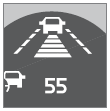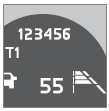 Volvo S60: Setting a time interval
Volvo S60: Setting a time interval
The set time interval to vehicles ahead can be increased by pressing
 and decreased by pressing
and decreased by pressing
 . The current time interval is shown
briefly in the display following adjustment.
. The current time interval is shown
briefly in the display following adjustment.
 Different time intervals
can be selected and are shown in the display as 1–5 horizontal bars. The greater
the number of bars, the longer the time interval.
Different time intervals
can be selected and are shown in the display as 1–5 horizontal bars. The greater
the number of bars, the longer the time interval.
One bar represents a time interval of approximately 1 second; 5 bars is approximately 2.5 seconds. At low speeds, when the distance to the vehicle ahead is short, ACC increases the time interval slightly. In order to follow the vehicle ahead as smoothly as possible, ACC allows the time interval to vary considerably in certain situations.
![]() WARNING
WARNING
- Only use a time interval that is suitable in current traffic conditions.
- A short time interval gives the driver limited reaction time if an unexpected situation occurs in traffic.
 The number of bars indicating
the selected time interval are shown while the setting is being made and for several
seconds afterward. A smaller version of the symbol is then shown to the right in
the display. The same symbol is also displayed when Distance Alert is in active
mode, see page 165 .
The number of bars indicating
the selected time interval are shown while the setting is being made and for several
seconds afterward. A smaller version of the symbol is then shown to the right in
the display. The same symbol is also displayed when Distance Alert is in active
mode, see page 165 .
 Changing the set speed
Changing the set speed
After a speed has been set, it can be increased or decreased by using the
or
buttons. Each time one of these buttons
is pressed, the vehicle's speed changes by 5 mph (approximately 8 km/h).
...
 Standby mode (temporary deactivation)
Standby mode (temporary deactivation)
Press to temporarily deactivate
cruise control (put it in standby mode). The set speed, for example 55 mph, is then
shown in parentheses. The previously set speed and time interval are resumed by ...
See also:
Technical specifications
Wheel nut torque
Tyre pressures (cold tyres)
Up to 80 km/h (50 mph)
Tyre pressures
All speeds
Tyre pressures
...
Coolant temperature display
WARNING
Driving when your engine is overheated can
cause some fluids which may have leaked into
the engine compartment to catch fire. You
could be seriously burned.
Steam from an overheate ...
Checking Loads
The best way to confirmthat all
loads are within limits is to check
them at a public scale. For public
scales in your area, check your local
phone book, or contact your trailer
dealer or ren ...
